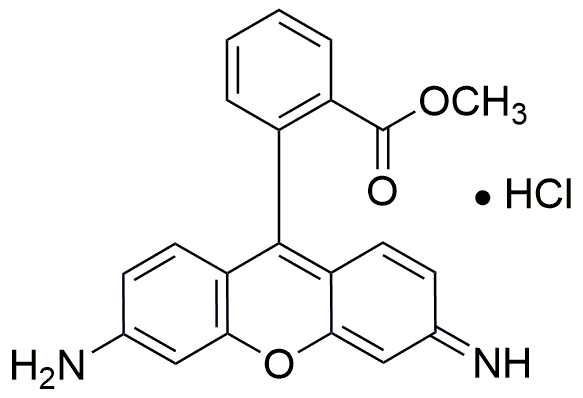Rhodamine 123 is widely utilized in research focused on:
- Fluorescent Tracers: Commonly used in biological imaging, Rhodamine 123 serves as a fluorescent tracer to visualize cellular processes, making it invaluable in cell biology and pharmacology.
- Drug Delivery Studies: Its properties allow researchers to track the distribution of drugs within organisms, aiding in the development of targeted therapies and improving treatment efficacy.
- Mitochondrial Studies: This compound is particularly effective in studying mitochondrial function and dynamics, helping researchers understand energy metabolism and its implications in diseases.
- Environmental Monitoring: Rhodamine 123 is used in environmental science to trace water pollution and assess the movement of contaminants in aquatic systems, providing critical data for remediation efforts.
- Diagnostic Applications: In medical research, it is employed in assays to detect cellular viability and apoptosis, offering insights into cancer research and potential therapeutic interventions.
Informations générales
Propriétés
Sécurité et réglementation
Applications
Rhodamine 123 is widely utilized in research focused on:
- Fluorescent Tracers: Commonly used in biological imaging, Rhodamine 123 serves as a fluorescent tracer to visualize cellular processes, making it invaluable in cell biology and pharmacology.
- Drug Delivery Studies: Its properties allow researchers to track the distribution of drugs within organisms, aiding in the development of targeted therapies and improving treatment efficacy.
- Mitochondrial Studies: This compound is particularly effective in studying mitochondrial function and dynamics, helping researchers understand energy metabolism and its implications in diseases.
- Environmental Monitoring: Rhodamine 123 is used in environmental science to trace water pollution and assess the movement of contaminants in aquatic systems, providing critical data for remediation efforts.
- Diagnostic Applications: In medical research, it is employed in assays to detect cellular viability and apoptosis, offering insights into cancer research and potential therapeutic interventions.
Documents
Fiches de données de sécurité (FDS)
La FDS fournit des informations de sécurité complètes sur la manipulation, le stockage et l’élimination du produit.
Spécifications du produit (PS)
Le PS fournit une description complète des propriétés du produit, notamment sa composition chimique, son état physique, sa pureté et les exigences de stockage. Il détaille également les plages de qualité acceptables et les applications prévues du produit.
Certificats d'analyse (COA)
Recherchez des certificats d'analyse (COA) en saisissant le numéro de lot du produit. Les numéros de lot et de lot se trouvent sur l'étiquette d'un produit, après les mots « Lot » ou « Lot de fabrication ».
Numéro de catalogue
Numéro de lot/série
Certificats d'origine (COO)
Ce certificat d'exploitation confirme le pays dans lequel le produit a été fabriqué, et détaille également les matériaux et composants utilisés et s'il est issu de sources naturelles, synthétiques ou autres sources spécifiques. Ce certificat peut être requis pour les douanes, le commerce et la conformité réglementaire.
Numéro de catalogue
Numéro de lot/série
Fiches de données de sécurité (FDS)
La FDS fournit des informations de sécurité complètes sur la manipulation, le stockage et l’élimination du produit.
DownloadSpécifications du produit (PS)
Le PS fournit une description complète des propriétés du produit, notamment sa composition chimique, son état physique, sa pureté et les exigences de stockage. Il détaille également les plages de qualité acceptables et les applications prévues du produit.
DownloadCertificats d'analyse (COA)
Recherchez des certificats d'analyse (COA) en saisissant le numéro de lot du produit. Les numéros de lot et de lot se trouvent sur l'étiquette d'un produit, après les mots « Lot » ou « Lot de fabrication ».
Numéro de catalogue
Numéro de lot/série
Certificats d'origine (COO)
Ce certificat d'exploitation confirme le pays dans lequel le produit a été fabriqué, et détaille également les matériaux et composants utilisés et s'il est issu de sources naturelles, synthétiques ou autres sources spécifiques. Ce certificat peut être requis pour les douanes, le commerce et la conformité réglementaire.


